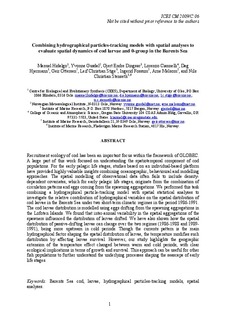Combining hydrographical particles-tracking models with spatial analyses to evaluate spatial dynamics of cod larvae and 0-group in the Barents Sea
Hidalgo, Manuel; Gusdal, Yvonne; Dingsør, Gjert Endre; Ciannelli, Lorenzo; Hjermann, Dag Ø.; Ottersen, Geir; Stige, Leif Christian; Fossum, Ingerid; Melsom, Arne; Stenseth, Nils Christian
Working paper

Åpne
Permanent lenke
http://hdl.handle.net/11250/102936Utgivelsesdato
2009Metadata
Vis full innførselSamlinger
Sammendrag
Recruitment ecology of cod has been an important focus within the framework of GLOBEC.
A large part of this work focused on understanding the spatiotemporal component of cod
populations. For the early pelagic life stages, studies based on an individual-based platform
have provided highly valuable insights combining oceanographic, behavioural and modelling
approaches. The spatial modelling of observational data often fails to include densitydependent
covariates, which for early pelagic life stages, originate from the combination of
circulation patterns and eggs coming from the spawning aggregations. We performed this task
combining a hydrographical particle-tracking model with spatial statistical analyses to
investigate the relative contribution of hydrographical variables on the spatial distribution of
cod larvae in the Barents Sea under two short-term climatic regimes in the period 1986-1991.
The cod larvae distribution is modelled using eggs drifting from the spawning aggregations in
the Lofoten Islands. We found that inter-annual variability in the spatial aggregations of the
spawners influenced the distribution of larvae drifted. We have also shown how the spatial
distribution of passive-drifting larvae can change over the two regimes (1986-1988 and 1989-
1991), being more upstream in cold periods. Though the currents pattern is the main
hydrographical factor shaping the spatial distribution of larvae, the temperature modifies such
distribution by affecting larvae survival. However, our study highlights the geographic
extension of the temperature effect changed between warm and cold periods, with clear
ecological implications in terms of growth and survival. This approach can be useful for other
fish populations to further understand the underlying processes shaping the seascape of early
life stages.
Keywords: Barents Sea cod, larvae, hydrographical particles-tracking models, spatial
analyses.